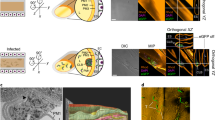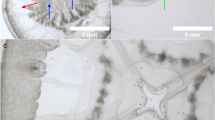Abstract
THE life-history of Fasciola hepatica has been recounted in nearly every text-book of zoology or of parasitology since it was elucidated by R. Leuckart (1881–82) and A. P. Thomas (1881–83). In spite of this and much original work by other investigators our knowledge of (a) the form which penetrates the snail host and (b) the manner of its penetration is misconceived. For example, in the modern account given by G. Lapage1 it is stated that once a snail has been found, the miracidium “applies the papilla at its broadest, anterior end to the soft skin of the snail and, spinning by means of its cilia on its long axis, it drives the papilla into the snail and penetrates the snail's body”. Other writers have introduced something between this sort of statement and the more correct idea, succinctly expressed by Faust2, that penetration “is accomplished by the secretion of digestive enzymes elaborated in the so-called ‘penetration glands’ which discharge the secretion at the anterior end of the miracidium”. It is difficult to prove that ‘digestive secretions’ are produced, or even to demonstrate the cytological effects produced by a penetrating larva which is smaller than some ciliated protozoa. It is here shown, for the first time by means of photomicrographs, that the miracidium creates a perforation in the snail's integument by the loosening, cytolysis and abstraction of epithelial cells, an action which appears to be chemical rather than mechanical and is probably the result of enzyme activity. It will be shown also that, because the miracidium loses its ciliated epithelium and is in other ways transformed before penetration is effected, it is an early sporocyst and not a miracidium which enters the snail.
This is a preview of subscription content, access via your institution
Access options
Subscribe to this journal
Receive 51 print issues and online access
$199.00 per year
only $3.90 per issue
Buy this article
- Purchase on Springer Link
- Instant access to full article PDF
Prices may be subject to local taxes which are calculated during checkout
Similar content being viewed by others

References
Lapage, G., “Veterinary Parasitology” (Oliver and Boyd, 1956).
Faust, E. C., “Animal Agents and Vectors of Human Disease” (Philadelphia, 1955).
Mattes, O., Z. Parasitenk., 14, 320 (1949).
Author information
Authors and Affiliations
Rights and permissions
About this article
Cite this article
DAWES, B. Penetration of the Liver-fluke, Fasciola hepatica into the Snail, Limnaea truncatula . Nature 184, 1334–1335 (1959). https://doi.org/10.1038/1841334a0
Issue Date:
DOI: https://doi.org/10.1038/1841334a0
This article is cited by
-
Localization and outcome ofFasciola hepatica sporocysts inLymnaea truncatula subjected to mono- or plurimiracidial exposure
Parasitology Research (1995)
-
The penetration of Fascioloides magna miracidia into the snail host Fossaria bulimoides
Zeitschrift f�r Parasitenkunde (1977)
-
Elucidation of the Life-cycle of Fasciola hepatica
Nature (1960)
-
Penetration of Fasciola gigantica Cobbold, 1856 into Snail Hosts
Nature (1960)
Comments
By submitting a comment you agree to abide by our Terms and Community Guidelines. If you find something abusive or that does not comply with our terms or guidelines please flag it as inappropriate.


